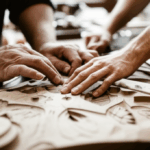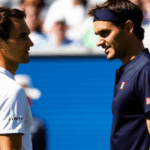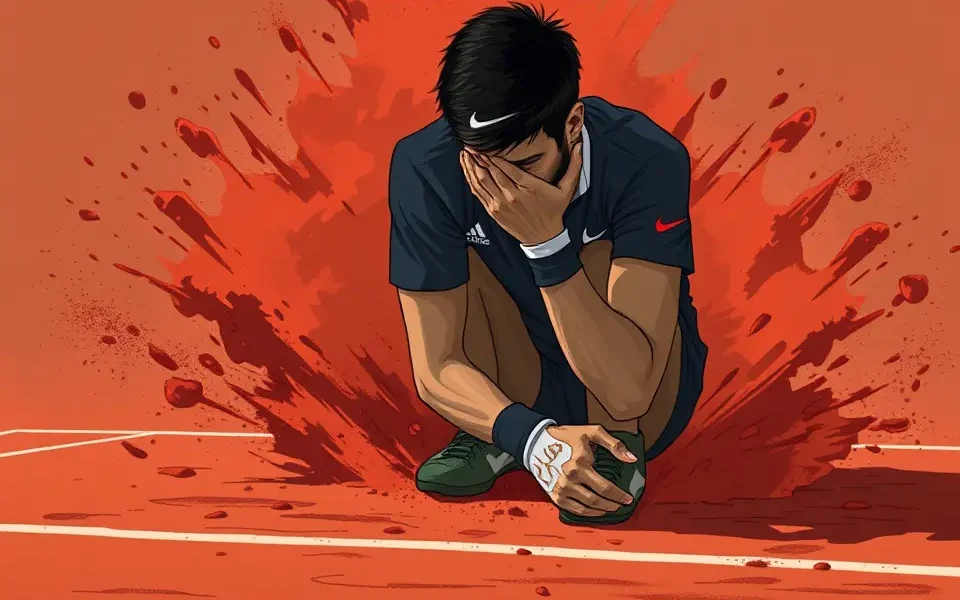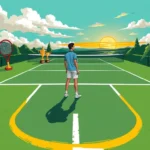Novak Djokovic, the world-renowned tennis superstar, has issued an apology following his unexpected exit from the Monte Carlo Masters. While the defeat stings, it also serves as a stark reminder of the challenges he faces as he navigates this stage of his illustrious career.
Early Exit Stuns Fans and Djokovic Himself
Djokovic’s early departure from the Monte Carlo Masters sent ripples through the tennis world. As a two-time champion at this prestigious event, his loss was particularly surprising. After the match, Djokovic didn’t shy away from expressing his disappointment. He acknowledged his subpar performance and offered an apology to his fans, who had anticipated a strong showing from him on the clay courts of Monte Carlo.
“Sorry” Signals Awareness and Accountability
The Serbian champion’s use of the word “sorry” wasn’t just a formality; it underscored his understanding of the high expectations placed upon him. It reflected his own internal standards and his commitment to delivering his best, even when faced with adversity. This public acknowledgment of his shortcomings resonates with fans who appreciate his honesty and accountability.
Brutal Verdict: A Candid Assessment of His Game
Beyond the apology, Djokovic delivered a “brutal verdict” on his performance. While the exact words may vary depending on the source, the sentiment remains consistent: he was far from his best. This self-assessment, though harsh, is characteristic of Djokovic’s relentless pursuit of improvement. He holds himself to the highest standards, and when he falls short, he doesn’t sugarcoat the reality.
Possible factors in Djokovic’s assessment:
- Inconsistent Play: Djokovic may have pointed to fluctuations in his level of play throughout the match, highlighting moments where he failed to maintain consistency.
- Errors and Missed Opportunities: He might have criticized his own errors, particularly on crucial points, and lamented missed opportunities to seize control of the match.
- Lack of Sharpness: Djokovic could have noted a lack of sharpness in his game, attributing it to factors such as adapting to the clay surface or a dip in his physical conditioning.
- Opponent’s Performance: While primarily focusing on his own game, Djokovic might have acknowledged the quality of his opponent’s play, recognizing that they performed well and deserved the victory.
Context: Monte Carlo and the Clay Season
The Monte Carlo Masters marks the beginning of the European clay court season, a segment of the tennis calendar that presents unique challenges. The slower surface demands patience, tactical adjustments, and exceptional physical endurance. For Djokovic, who has historically achieved great success on all surfaces, the transition to clay requires a period of adaptation.
The Road Ahead: Adjustments and Expectations
Djokovic’s Monte Carlo exit serves as a valuable learning experience. He will undoubtedly analyze his performance, identify areas for improvement, and fine-tune his game as he prepares for upcoming tournaments. The clay court season is a marathon, not a sprint, and Djokovic has ample time to find his rhythm and peak form.
What’s Next for Djokovic?
- Madrid Open and Italian Open: These are the next major clay-court events leading up to the French Open. Djokovic will likely participate in at least one, if not both, to gain match practice and refine his clay-court game.
- French Open: The ultimate goal of the clay-court season is the French Open at Roland Garros. Djokovic will be aiming to add to his Grand Slam tally and solidify his place in tennis history.
Is this the beginning of the end?
While some may interpret this loss as a sign of decline, it’s crucial to remember Djokovic’s track record. He has consistently defied expectations and overcome challenges throughout his career. It’s premature to write him off based on one tournament. However, it does highlight the increasing competitiveness of the men’s game and the emergence of new stars who are eager to challenge the established order.
A Champion’s Perspective
Djokovic’s response to his Monte Carlo defeat exemplifies the mindset of a true champion. He acknowledges his failures, takes responsibility, and uses them as fuel for improvement. His “sorry” is not a sign of weakness, but rather a testament to his unwavering commitment to excellence and his deep respect for the game and his fans. As he continues his clay-court journey, expect him to draw upon his vast experience and relentless work ethic to strive for success.
Monte Carlo Masters: More Than Just a Tournament
The Monte Carlo Masters is more than just another stop on the ATP Tour; it’s an event steeped in history and tradition. The picturesque setting, the challenging clay courts, and the presence of the world’s top players combine to create a unique and unforgettable tennis experience.
A Brief History
- Origins: The tournament dates back to 1897, making it one of the oldest and most prestigious tennis events in the world.
- Location: The Monte Carlo Country Club, with its stunning views of the Mediterranean Sea, has been the tournament’s home since 1928.
- Surface: The red clay courts of Monte Carlo are renowned for their demanding nature, testing players’ patience, fitness, and tactical acumen.
- Champions: The tournament has been won by some of the greatest names in tennis history, including Rafael Nadal, Bjorn Borg, and Novak Djokovic.
Key Moments and Notable Facts
- Nadal’s Dominance: Rafael Nadal holds the record for the most Monte Carlo Masters titles, with an astounding 11 victories.
- Djokovic’s Triumphs: Novak Djokovic has won the tournament twice, in 2013 and 2015, showcasing his ability to excel on clay.
- Upsets and Surprises: The Monte Carlo Masters has witnessed its fair share of upsets and unexpected results, adding to its allure and unpredictability.
- A Social Event: The tournament is also a glamorous social event, attracting celebrities and dignitaries from around the world.
The Allure of Clay: A Unique Challenge
Clay court tennis is a distinct discipline, demanding a different skill set and strategy than hard or grass courts. The slow, high-bouncing surface favors players with exceptional footwork, patience, and the ability to construct points meticulously.
Key Characteristics of Clay Court Tennis
- Slower Pace: The clay surface slows down the ball, giving players more time to react and extending rallies.
- Higher Bounce: The ball bounces higher on clay, making it more challenging to hit flat, penetrating shots.
- Sliding: Players often slide into their shots on clay, allowing them to cover more ground and maintain balance.
- Tactical Emphasis: Clay court tennis rewards tactical thinking, with players often employing drop shots, lobs, and changes of pace to outmaneuver their opponents.
Adjusting to Clay: A Mental and Physical Battle
For players accustomed to faster surfaces, adapting to clay requires a significant adjustment. It’s not just about hitting different shots; it’s about adopting a different mindset.
- Patience is Key: Clay court matches can be long and grueling, testing players’ mental fortitude and stamina.
- Footwork is Crucial: Efficient footwork is essential for covering the court and maintaining balance on the slippery surface.
- Spin is Your Friend: Generating topspin allows players to control the ball’s trajectory and create difficult angles for their opponents.
- Embrace the Grind: Clay court tennis is often a battle of attrition, requiring players to embrace the grind and fight for every point.
Analyzing Djokovic’s Game on Clay
Novak Djokovic’s success on clay is a testament to his adaptability and all-around excellence. While he may not possess the same natural affinity for the surface as Rafael Nadal, he has consistently challenged and defeated the Spaniard on numerous occasions.
Strengths and Weaknesses
- Strengths:
- Return of Serve: Djokovic’s exceptional return of serve is a weapon on any surface, allowing him to neutralize opponents’ serves and gain an immediate advantage.
- Movement and Defense: His remarkable court coverage and defensive skills enable him to retrieve seemingly impossible shots and extend rallies.
- Mental Fortitude: Djokovic’s mental toughness and unwavering belief in his abilities are crucial assets in the demanding environment of clay court tennis.
- Weaknesses:
- Aggressiveness: Djokovic can sometimes be too passive on clay, allowing his opponents to dictate play.
- Patience: While generally patient, he can occasionally become impatient and rush his shots, leading to errors.
Tactical Approaches
- Aggressive Return: Djokovic aims to put pressure on his opponents’ serves from the very first shot.
- Consistent Depth: He focuses on hitting deep, penetrating shots that push his opponents behind the baseline.
- Strategic Use of Slice: Djokovic utilizes the slice to disrupt his opponents’ rhythm and create opportunities to attack.
- Capitalizing on Opportunities: He is adept at seizing opportunities to step inside the court and dictate play with his forehand.
The Mental Game: Overcoming Setbacks
Tennis is as much a mental battle as it is a physical one. Players must be able to handle pressure, overcome adversity, and maintain their focus in the face of distractions. Djokovic’s mental game is one of his greatest strengths, but even he is not immune to the occasional setback.
Strategies for Mental Resilience
- Positive Self-Talk: Djokovic uses positive affirmations and self-talk to maintain his confidence and belief in his abilities.
- Focus on the Present: He tries to stay in the present moment, avoiding dwelling on past mistakes or worrying about future outcomes.
- Visualization: Djokovic uses visualization techniques to mentally rehearse his game and prepare for different scenarios.
- Emotional Control: He strives to maintain emotional control, avoiding displays of anger or frustration that could negatively impact his performance.
Learning from Losses
Losses are an inevitable part of tennis, even for the greatest players. The key is to learn from them and use them as motivation to improve. Djokovic has a proven track record of bouncing back from defeats and using them as fuel for future success.
Legacy and Future Aspirations
Novak Djokovic has already cemented his place as one of the greatest tennis players of all time. His achievements are staggering, and his impact on the sport is undeniable. However, he is not content to rest on his laurels. He continues to push himself to new heights, seeking to add to his Grand Slam tally and further solidify his legacy.
Goals and Ambitions
- More Grand Slam Titles: Djokovic’s primary goal is to win more Grand Slam titles and surpass Roger Federer and Rafael Nadal in the all-time standings.
- Continued Dominance: He aims to maintain his position at the top of the rankings and continue to dominate the men’s game.
- Inspiring the Next Generation: Djokovic is passionate about inspiring the next generation of tennis players and promoting the sport around the world.
Impact on the Sport
- Raising the Bar: Djokovic has raised the bar for athleticism, fitness, and mental toughness in tennis.
- Global Appeal: His global appeal has helped to expand the sport’s reach and attract new fans from around the world.
- Philanthropic Efforts: Djokovic is actively involved in philanthropic efforts, using his platform to make a positive impact on society.
Conclusion: A Champion’s Journey
Novak Djokovic’s “sorry” after his Monte Carlo exit is a reminder that even the greatest athletes face challenges and setbacks. However, it’s his response to those challenges that defines him as a champion. His honesty, accountability, and relentless pursuit of improvement are qualities that inspire fans around the world. As he continues his clay-court journey, expect him to draw upon his vast experience, mental fortitude, and unwavering determination to strive for success and further solidify his legacy as one of the greatest tennis players of all time. His career is a testament to resilience, dedication, and the unwavering pursuit of excellence. While the Monte Carlo exit may sting, it’s just another chapter in the ongoing story of a true champion.








No Comment! Be the first one.